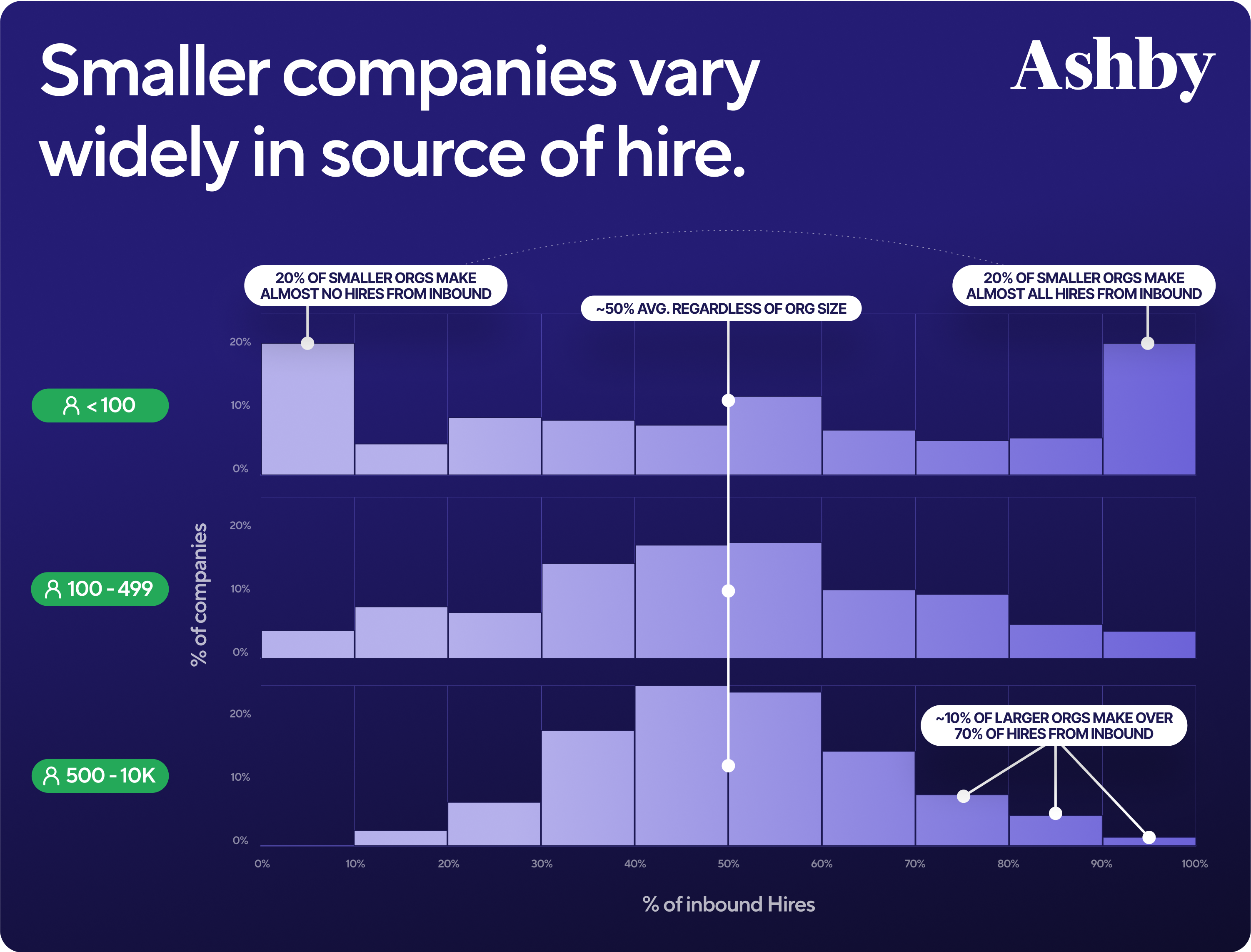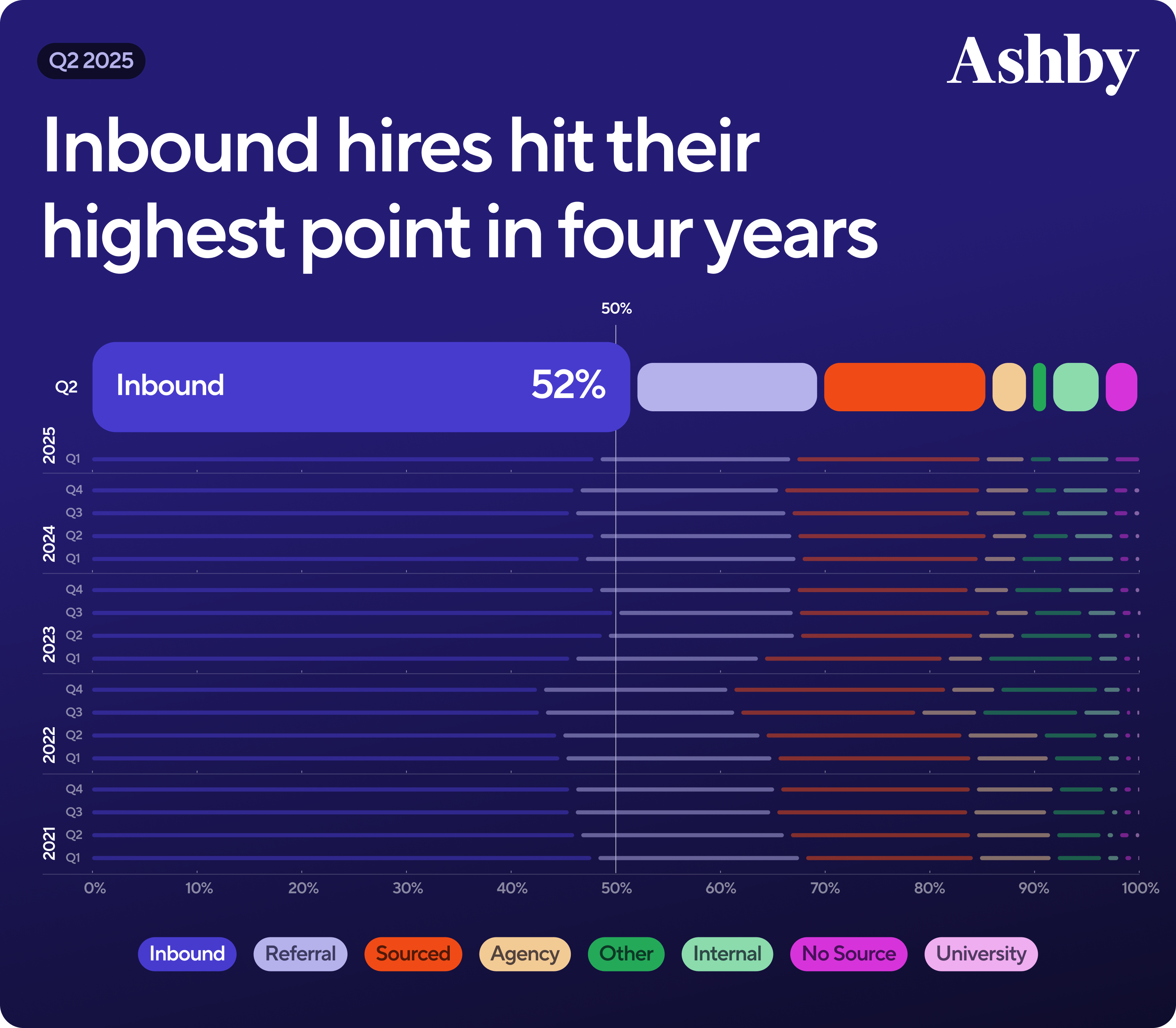5 minute read
Topics
How many hires really come from inbound?
For years, inbound has quietly (and consistently) dominated as a source of hires. Even as referred and sourced candidates earn their reputation for higher conversion rates, inbound applicants continue to make up the majority of hires — over the past four years, they’ve accounted for between 43% and 52% of all hires.
Though that part isn’t all that surprising given inbound makes up a large share of applications (more on this later). What is surprising is how differently companies rely on inbound. Underneath “inbound dominates” is a striking amount of variation.
This report analyzes nearly 250K hires between Jan 2021 and June 2025, looking at the source of hire across inbound, referral, sourced, agency, and internal hires.
1. Smaller companies vary widely in source of hire.
At first glance, inbound hires seem steady, averaging around 50% across all company sizes. But that average hides a wide spread. We see that:
-
Small organizations show a “dumbbell” pattern, with some leaning heavily inbound and others leaning heavily on alternative sources.
-
Enterprise organizations converge closer to the middle, with nearly half of companies making the majority of hires from inbound.
- Even at scale, inbound remains dominant: about 10% of 500–10,000 employee companies hire 70%+ of roles from inbound.

2. Inbound applicants make up the majority of hires.
While inbound experiences wide variance across company sizes, the channel has remained the largest hiring source. In Q2 2025, inbound hires hit their highest point in four years at 52% of all hires. That’s a +9 percentage point increase compared to Q4 2022. While the data does not explain all the context around what is driving this increase, factors such as increase in inbound application volume over recent years or strong candidates on the market after a series of industry layoffs could mean there’s simply more candidates in this pool to select from.
Meanwhile, other sources have been more stable:
- Hires from sourced (~16%) and referral (~18%) held steady
- Agency hires declined slightly
- Internal hires are on the rise, though still a small fraction overall

3. When inbound is low, sourcing dominates.
At the job level, when inbound applications make a greater share of the total pipeline, it is more likely that the hire will come from inbound.
- For jobs with few inbound applications, sourcing is the top driver of hires.
- As inbound applications increase, so do inbound hires, while sourcing decreases in share.
- Referrals, interestingly, stay consistent at ~17% of hires regardless of inbound volume.
This suggests that referrals remain valuable across all hiring strategies while sourcing fills the gaps when inbound volume is low (or when highly specialized roles need to be filled). It’s also worth noting that since inbound is often the largest source of applications, many jobs end up being filled with an inbound applicant; sourced hires tend to come from jobs with a lower proportion of inbound. We recently explored if referred candidates are more likely to get hired in a previous report here.
Adjacent findings worth noting:
Naturally, there’s an abundance of additional insights we could pull if we kept digging. A few teasers worth highlighting for now:
- Executive roles are less likely to be filled through inbound (~35%)
- Tech jobs skew toward sourcing (24%) compared to business roles (18%)
- Business jobs skew more inbound-heavy than tech
How Ashby Manages Inbound
At Ashby, we see technology as the bridge: Our own Jim Miller recently reviewed 1,500 applications in 6 hours using AI-Assisted App Review, a feature we released to empower talent professionals with assistive, governed tools.
Since then, fraudulent candidates have begun creeping their way into the droves of inbound applications companies are receiving, only further exacerbating the increased difficulty in managing inbound volume. We recently announced Fraudulent Candidate Detection, and will be exploring the impact these fake candidates have in the overall inbound pipeline in the future. To stay updated on these new insights, subscribe to our Talent Trends newsletter.